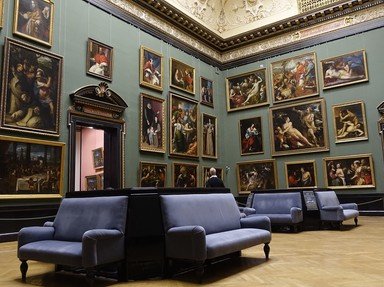Quiz Answer Key and Fun Facts
1. Most New York schoolchildren can recall a field trip to the Met, which almost always involves a fascinating tour of the Egyptian galleries. They probably paid more attention to the mummies, of which the Museum boasts several, but what's that blue hippopotamus made from?
2. The span of art in Egypt is enormously long. Our next work of art is the Temple of Dendur, which was installed in the Met's purpose-built, soaringly airy Sackler Wing in 1978. Although the temple looks as Egyptian as any in the Valley of Kings, it is from Egypt's Roman Period and dates from about 15 BCE. The Pharaoh depicted in full Egyptian regalia on its walls is actually Caesar Augustus. Why is the Temple of Dendur in New York?
3. Our next stop is the Department of Ancient Near Eastern Art. This magnificent collection spans more than eight thousand years and includes thousands of historically significant as well as beautiful artifacts. Which of the following will NOT be found in these galleries?
4. The Met's collection of Greek and Roman art is among the world's finest. Included in the Galleries are several examples of a "kouros". Which of the following describes this?
5. The Islamic Art Galleries of the Met are undergoing a renovation which will require years, but when it is completed everyone will be again be able to view my favorite area: the Nur al-Din Room (A.D. 1707). This beautiful room, complete with fountain, belonged to a wealthy Syrian family of what historic period?
6. As if the main branch of the Met weren't cavernous enough, the museum also includes The Cloisters, which is the branch of the museum devoted to the art and architecture of medieval Europe. In a serene, landmarked building in northern Manhattan, visitors can view sculpture, tapestries, illuminated manuscripts, gold and silver, stained glass, enamels, ivories, and more, all dating from the 12th through the 15th century. The collection includes several medieval "reliquaries"...what might those be?
7. Which of the following is NOT featured in the Metropolitan Museum's Asian art collection?
8. Another exceeding popular group of galleries at the Met are those filled with over 15,000 examples of Arms and Armor. All of the full sets of armor below are part of its collection. Three of them are from the 16th century; which one was crafted a hundred years later?
9. Is the Metropolitan Museum of Art's collection of the Department of the Arts of Africa, Oceania, and the Americas housed in a gallery named for Nelson Rockefeller?
10. In which of the Metropolitan Museum's galleries would you find a sankh, a bondjo, and a mandola?
11. Does the Metropolitan Museum of Art own a Vermeer?
12. The Metropolitan Museum also boasts a wonderful collection of books and manuscripts, including an 1893 British copy of "Le Morte D'Arthur" illustrated by which of these notable artists?
13. As special consultant from 1973 to 1989, Diana Vreeland helped organize exhibitions for what Metropolitan Museum department?
14. The Met possesses an extensive collection of American decorative art, including the exquisite stained glass windows "A View of Oyster Bay" and "Magnolias and Irises" by this artist.
15. Perhaps you've "done" all the Met's other galleries and saved Modern Art for last, or maybe it is your first destination. In either case, which of the works below will you NOT find at the Met?
Source: Author
LilahDeDah
This quiz was reviewed by FunTrivia editor
agony before going online.
Any errors found in FunTrivia content are routinely corrected through our feedback system.

